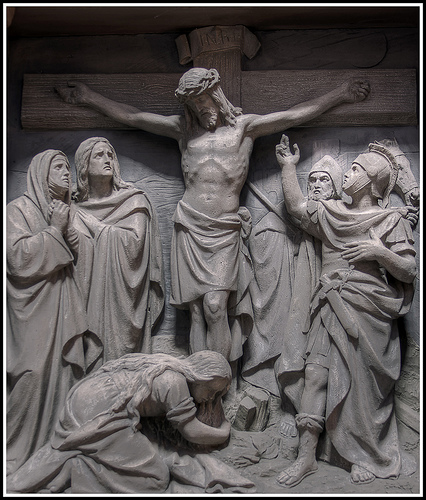The Stations of the Cross7:00PM on the Fridays of Lent
 As early as the 4th c., Christian pilgrims to the Holy Land would walk the route that Our Lord walked as He made His way to Golgotha for our salvation. When Muslims captured Jerusalem and it became too dangerous to make this pilgrimage, Christians replicated the sites back home in Europe, and there developed the "Stations of the Cross" devotion (also known as "Way of the Cross," "Via Dolorosa," or "Via Crucis"). The devotion consists of meditating on 14 events -- that number being fixed in 1731 by Pope Clement XII -- which took place during Christ's Passion, from His being condemned to His burial. Franciscans popularized the devotion, which was originally made outside, often along roads to shrines or churches. The Way of the Cross can still be made outside but is usually made inside nowadays, especially during the Season of Lent and most especially on Good Friday.
If you enter a Catholic Church and look along the walls of the nave (where the parishioners sit), you should see 14 representations on the walls which depict 14 events of Christ's Passion that have been singled out for contemplation. It is at these blessed artistic representations, these "stations" -- which can be painted, carved, engraved, of wood, metal, paint on canvas, etc., topped with a wooden Cross -- that the Way of the Cross is made during public liturgy. The Way of the Cross can also be made privately, even at home, with or without "visual aids."
As early as the 4th c., Christian pilgrims to the Holy Land would walk the route that Our Lord walked as He made His way to Golgotha for our salvation. When Muslims captured Jerusalem and it became too dangerous to make this pilgrimage, Christians replicated the sites back home in Europe, and there developed the "Stations of the Cross" devotion (also known as "Way of the Cross," "Via Dolorosa," or "Via Crucis"). The devotion consists of meditating on 14 events -- that number being fixed in 1731 by Pope Clement XII -- which took place during Christ's Passion, from His being condemned to His burial. Franciscans popularized the devotion, which was originally made outside, often along roads to shrines or churches. The Way of the Cross can still be made outside but is usually made inside nowadays, especially during the Season of Lent and most especially on Good Friday.
If you enter a Catholic Church and look along the walls of the nave (where the parishioners sit), you should see 14 representations on the walls which depict 14 events of Christ's Passion that have been singled out for contemplation. It is at these blessed artistic representations, these "stations" -- which can be painted, carved, engraved, of wood, metal, paint on canvas, etc., topped with a wooden Cross -- that the Way of the Cross is made during public liturgy. The Way of the Cross can also be made privately, even at home, with or without "visual aids."

